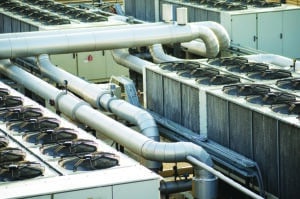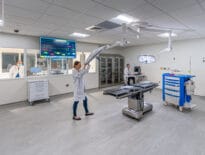
Strict requirements for climate-controlled experimentation and production spaces mean life science buildings have big energy demands which, in many cases, still need natural gas to meet.
Massachusetts has a long history of birthing new technologies and new industries, only to see them pack up and leave for sunnier climes, from textiles to computers.
Could we eventually see the life sciences sector bail as well in favor of competing industry clusters – not just in San Francisco, our main rival, but also now in Raleigh/Durham, San Diego and even scrappy Philadelphia?
Booming biotechs desperately want to stay and expand here, with Greater Boston’s cluster of top research universities and hospitals making the metro area – and to some extent the state as a whole – the logical place to be.
The sector is the Bay State’s leading growth engine by far, with developers working on plans that could triple the amount of lab space over the next few years, to more than 90 million square feet, up from 32 million now, according to Colliers.
Pharma giants and small biotech companies alike are looking to hire another 40,000 employees over three next three years alone.
But this high-flying success story now faces a head-on collision with a growing number of local campaigns to ban natural-gas hookups in most or all new buildings.
‘Energy Hogs’ Hard to Decarbonize
The state Senate recently unveiled a climate change bill that would allow 10 communities to ban new natural gas hookups, a group that includes Brookline, Concord, Lexington and Arlington.
While restaurants and retailers have opposed the ban, local media has paid inexplicably little if any attention to the impact on the life sciences sector, which is far more reliant on natural gas than is commonly understood.
The best HYM has been able to come up with is a 25/75 mix – 25 percent electricity, 75 percent gas.
Lab uses are described by insiders as “energy hogs,” requiring huge amounts of power even compared to your typical office building to do all sorts of research work in stable, climate-controlled environment.
Greg Vasil, chief executive of the Greater Boston Real Estate Board, likens the budding natural gas hookup bans to “shooting ourselves in the head.”
“The life sciences sector really saved us through the pandemic and it’s great to have its good paying jobs,” Vasil said. “I think we should be doing everything we can to foster that industry.”
Developers are now struggling to design new lab and biomanufacturing buildings that rely less on natural gas, but it’s not easy.
A top executive at HYM Investment Group, which is redeveloping the old Suffolk Downs racetrack site, told a recent gathering of engineers that reducing the reliance on natural gas in a new life science building planned for the site has been a challenge.
The best HYM has been able to come up with is a 25/75 mix – 25 percent electricity, 75 percent gas.
Gas Replacement Needs Existing Infrastructure
The proposed bans also come atop a landmark climate change bill passed by Beacon Hill last year, which paved the way for cities, towns and suburbs to impose tougher stretch energy codes to ratchet down building emissions.
Developers and commercial and multifamily building owners are already grappling with these new standards, which communities should give time to work, instead moving straight to fossil fuel bans, said Anastasia Nicolaou, vice president of policy and public affairs at real estate development trade group NAIOP Massachusetts.
“These communities that are looking at gas hookup bans want to do it immediately – tomorrow if they could,” Nicolaou said. “That is just not possible. There are so many economic ramifications that haven’t been thought through.”
And then there is the Biden administration’s recently announced plans to pump billions into research into “green hydrogen,” which has the potential to be game changer.
This new tech could provide an eventual replacement for natural gas while utilizing the same infrastructure as before – that is, if the pipes haven’t all been shut down prematurely.
Boston Economy at Stake
At stake is nothing less than the future of leading growth industry for the Boston area and the state.

Scott Van Voorhis
There are now proposals to add another 60 million square feet of additional life sciences-related space in Greater Boston, with 10 million of that involving “near-term” proposals, Aaron Jodka, director of U.S. capital markets for Colliers, said in a recent presentation to American Council of Engineering Companies members.
Helping fund that expansion, Massachusetts biotech companies landed more than $32 billion in funding in 2021, a record, roughly split between pre-IPO venture capital and post-IPO funding, Jodka said.
Flush with cash and expanding, as many 126 life sciences companies are on the hunt for as much as 50,000 square feet of lab and support space each, and 26 are looking to grab more than 100,000 square feet apiece, he said.
In addition, more than 3.8 million square feet of office space, in well more than a dozen buildings in the Boston area, are now being converted into lab space by developers, Jodka added.
That represents a lot of new growth and new jobs. Do we really want to put all that in jeopardy just so a few upscale suburbs can engage in what amounts to climate-change virtue signaling?
Didn’t think so.




 |
| 
